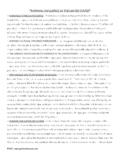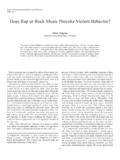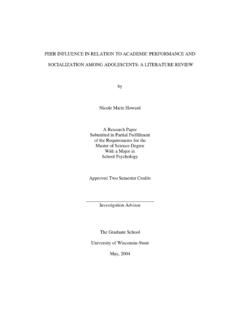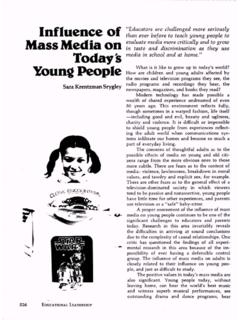Transcription of Colour and music. - musictheory21.com
1 - Color and music : p. 1 - Colour and music . The relationship between Colour and music as part of the complex consisting of music and the visual arts has not yet been systematically investigated. Since Liszt wrote Lo spozalizio from Ann es de P lerinage (1839), based on a painting by Raphael, compos-ers have often taken pictures as inspiration for their works (Fink, 1988, lists 711 such compositions). Conversely, painters have derived inspiration from musical composi-tions or the abstract idea of music . The subject of Colour and music encompasses the relationships between Colour and form, light and music , Colour and tonal intervals, col-our and sound, and indeed painting and music .
2 Cosmological ideas pervade the history of these relationships, from antiquity to the 20th century. 1. Colours as related to music . 2. music as related to colours. 3. Colour and music as an artistic synthesis. 4. Synaesthesia. J RG JEWANSKI 1. Colours as related to music . A theory of music founded on mathematical principles, and distinguishing between con-sonance and dissonance, has frequently been taken as the model for theories of Colour and the basis for establishing the harmony or disharmony of Colour combinations. The ancient Greeks were the first to construct a scale of colours divided into seven parts, on the analogy of the seven musical notes and the seven known planets.
3 In this scale, all colours derived from a mixture of black and white. Consonances of tonal intervals were transferred to colours (Aristotle, De sensu et sensibilibus, 439b 442a). Aristotle's theory of Colour was considered valid into the 17th century, and different colours were associ-ated with various tonal intervals in the 16th and 17th centuries, although usually in con-nection with further analogies in such heterogeneous fields as levels of being, the plan-ets, the elements, the phases of human life and degrees of knowledge. The aim of such analogies was to define a harmony of colours. Hieronymus Cardanus (De subtilitate, 1550, bk 13) associated seven colours, seven flavours and seven planets with each other.
4 Gioseffo Zarlino related the consonances of prime and octave to white and black, and - Color and music : p. 2 - the intermediate consonances to the intermediate colours of green, red and blue (Le isti-tutioni harmoniche, 1558, pt iii, ). Athanasius Kircher drew up complex tables of analogies, among other things associating musical notes, colours, intensities of light and degrees of brightness with each other (Ars magna lucis et umbrae, 1646, ). Four years later he devised a system associating colours with intervals (Musurgia universalis, 1650, i, 568). Marin Cureau de la Chambre transferred proportions derived from the musical theory of intervals to pairs of colours, and devised a Syst me des couleurs et des harmonies (Nouvelles observations et coniectures sur la nature de l'iris, 1650, ).
5 All these attempts at analogy, and many others of the period, were based on Ar-istotle's theory of Colour . Although the concrete associations of these systems cannot now be reconstructed in detail, and other works by their authors contain contradictions, it is clear that they represented a rational conception in which all phenomena were con-structed on the same principles and reflected the harmony of the world. Andr F libien, in 1666, was the first to establish yellow, red and blue as the basis of a new Colour system. At the same time Newton was making his first prismatic experi-ments, and in 1672 he associated tonal intervals with the Colour bands of the spectrum, for the Analogy of Nature is to be observed (An Hypothesis Explaining the Properties of Light, 1675).
6 There are lingering remnants of cosmological thinking in Newton too when he traces connections between colours, notes and planets. A relationship between Colour and musical intervals now seemed to have a physical foundation, and the idea had Newton's authority to support it. Reaction to his Opticks (1704), in which he re-turned to the analogy, can be observed in England, France, Germany and Russia. Under the influence of Newton, ideas of the relationship between Colour and music developed in all these countries (see Jewanski, 1999). The most intense discussion of the subject occurred in France.
7 After 1772 Rameau's writings constituted the point of departure in music theory: he regarded the individual chord as the core of the harmonic system, and derived musical phenomena from the harmonic series. Louis-Bertrand Castel, a French mathematician and philosopher, built on these new ideas. He knew the Colour theories of his day, the writings of antiquity and those of the 16th- and 17th-century theorists. Reviewing the French translation of New-ton's Opticks in 1723, he commented, with reference to Kircher's table of colours and intervals, that to all appearance the range of our senses is exactly the same, and nature gives us as many sounds as colours ( ).
8 After 1725 Castel developed his own sys-tem of colours and notes, starting with C = blue. He adopted the Colour theories of dyers and painters, rejecting those based on Newtonian physics. He simplified the relationship - Color and music : p. 3 - between colours and tonal intervals to a relationship between colours and notes, liber-ated it from its cosmological context, and at the same time attempted to transfer it to art as Farbenmusik ( Colour music ). He built a clavecin oculaire, or optical harpsichord , which he demonstrated for a small audience on 21 December 1754. Every key on the instrument, when pressed, opened up a shaft through which coloured light passed.
9 Cas-tel's invention complemented earlier attempts to give the theory of Colour a musical di-rection by adding the idea of an artistic synthesis. At the same time, the concept of a pure Colour display was born. The previously accepted application of harmonic principles to Colour combinations, al-though no longer regarded as a legacy of classical thinking, was now extended to the relationship between music and painting, and discussed in that light for the first time. Castel noted that painters often adopted the vocabulary of music , speaking of Colour tones, Colour harmonies and even Colour dissonances, while musicians described min-gled chords as imitating chiaroscuro.
10 He conceived of painting as simply a collection of colours and music as a collection of notes, and extended the comparison to a musique des couleurs, the translation of musical pieces into pictures. In 1739, on the basis of Castel's ideas, Telemann listed a number of truths that can be reduced to the following principles: the compass of notes runs from low through medium to high, and the range of colours from dark through medium to light; the movement of both notes and colours is either rising or falling and ranges from fast to slow; the distance between both notes and colours is from one to its neighbour; presentation in both cases may be simultane-ous or successive.






